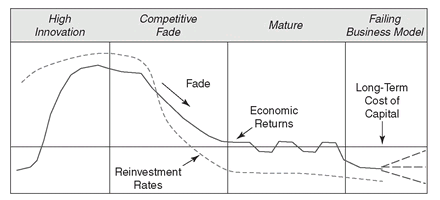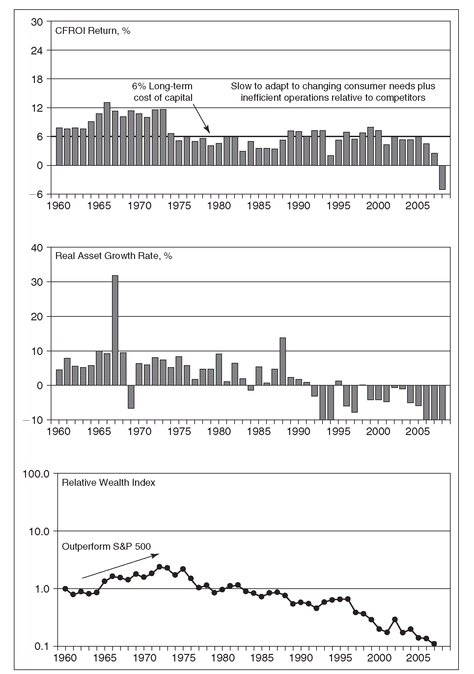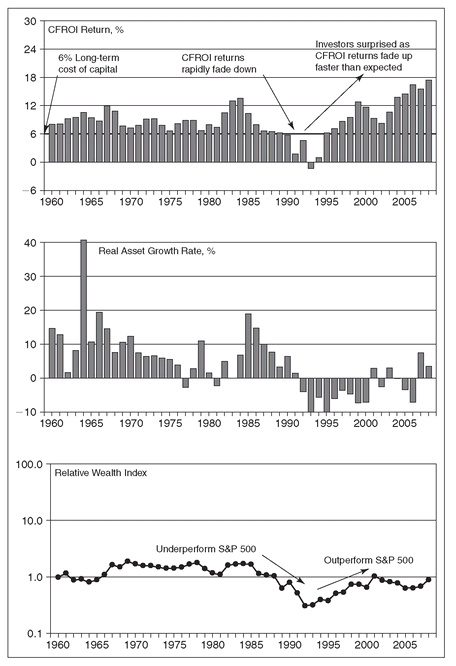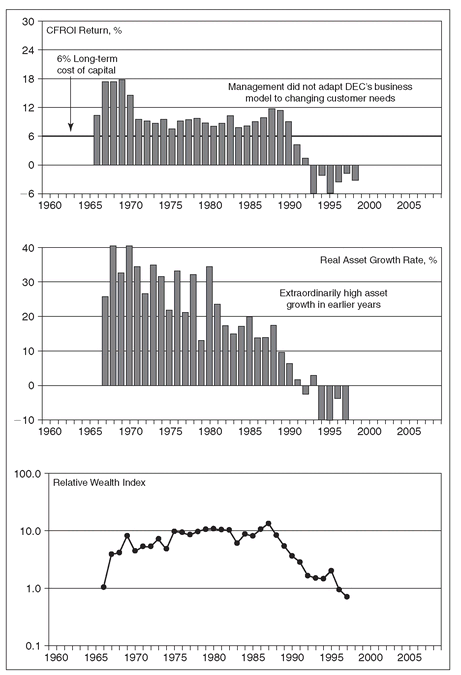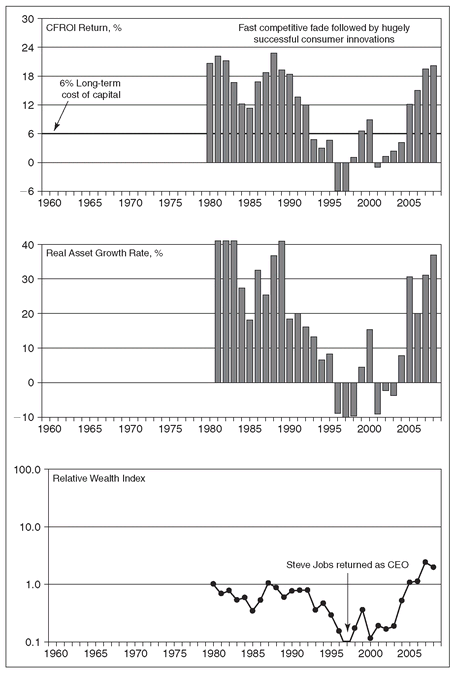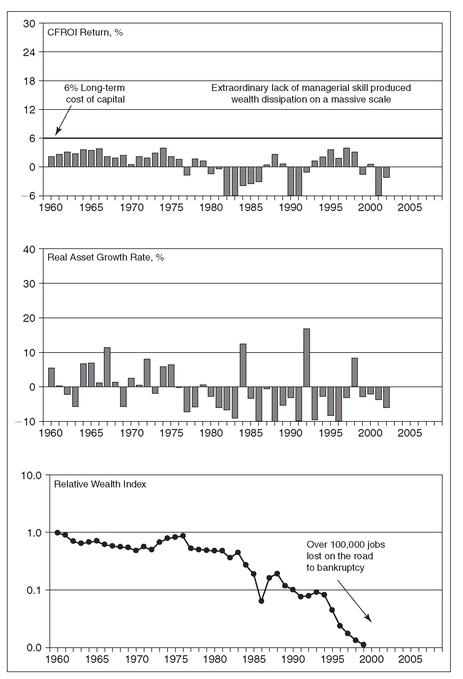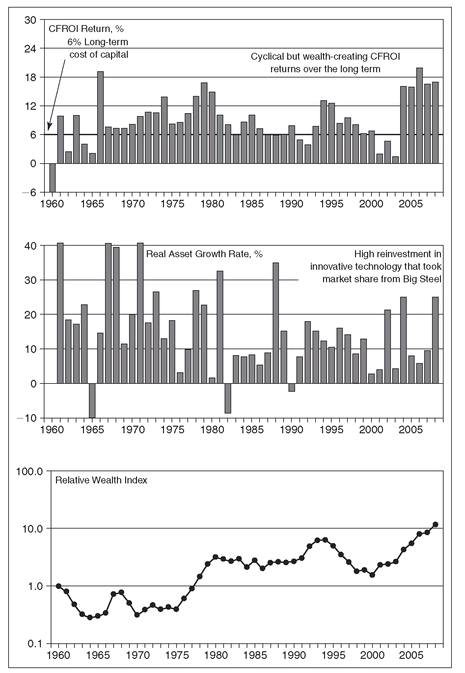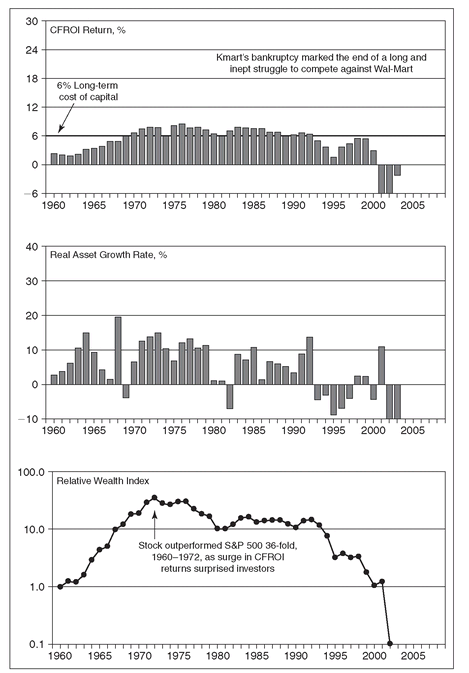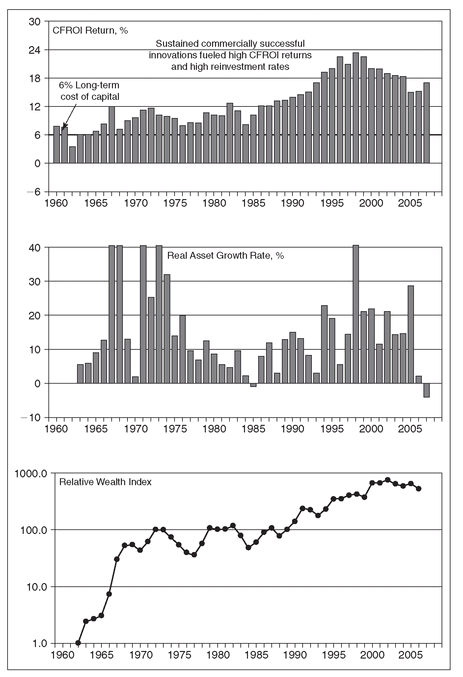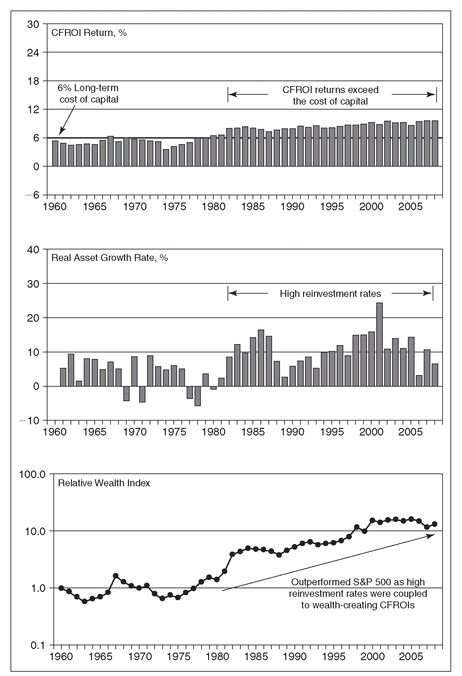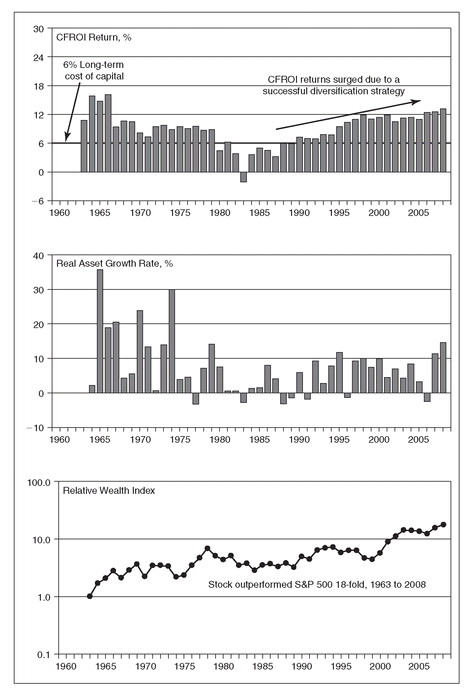CHAPTER 4
The Competitive Life-Cycle View of the Firm
There is no more important proposition in economic theory than that, under competition, the rate of return on investment tends towards equality in all industries. Entrepreneurs will seek to leave relatively unprofitable industries and enter relatively profitable industries.
—George Stigler, Capital and Rates of Return in Manufacturing Industries
Discussions about wealth creation and economic growth tend to involve aggregate measures of GDP, productivity, and the like, but the real action takes place at the firm level.
1 Over time, firms’ publicly traded stocks and bonds let us more directly measure producer wealth (equity and debt), which can be connected to its root cause, namely firms’ long-term financial performance. This connection, which can be established using what I call the
competitive life-cycle framework, provides uniquely valuable microeconomic data to policymakers, business leaders, and investors.
COMPETITIVE LIFE-CYCLE FRAMEWORK
The following eight points begin to explain how the competitive life-cycle framework connects firms’ financial performance to stock prices:
1. The goal of the firm should be to efficiently serve existing customer needs and to efficiently commercialize innovative new products and services that will be in demand in the future. This does not mean efficiency in an accounting sense, such as the cost of a unit produced. Excess production at a lower average cost per unit does not represent a gain in efficiency. Rather, efficiency improves as less resources are used to produce and better deliver precisely what customers want, when they want it, and without any of the hassles that waste consumers’ time and money (Womack and Jones, 2005). Successful management of a firm results in value delivered to customers over the long term with benefits accruing to both employees and shareholders.
2. Managerial skill is reflected in the vitality of the firm’s culture and the usefulness of the firm’s knowledge base so that existing processes keep improving and changes in the external environment are turned into future opportunities.
3. Firms face a competitive life cycle during which managerial skill continually confronts the force of competition. In economic terms, the bottom line of the competitive struggle is the firm’s long-term, expected net cash receipt stream—the primary determinant of producer wealth.
4. The life-cycle valuation model helps one to forecast and value net cash receipts in an intuitive manner, keyed to managerial skill and competition.
5. At any point in a firm’s life cycle, management’s resource allocation decisions should be focused on transitioning to a new life-cycle position that is favorable vis-à-vis competitive pressures.
6. Risk-adjusted, total shareholder returns for a particular time period will be greater (less) than the market return if the ending life-cycle position is more (less) favorable than investor expectations at the beginning of the period.
7. Bubbles in the stock market lead to expectations of firms’ future financial performance that are hard to justify on economic grounds. Nevertheless, on average, and over longer time periods, investor expectations turn out to be astute forecasts of the future. Consequently, management can obtain a reality check regarding their strategy and skillfulness in execution by quantifying, at any point in time, a snapshot of investor expectations. This exercise reveals a firm’s expected future life-cycle pattern of economic returns and reinvestment rates, and can be compared to similarly calculated expectations for industry competitors.
8. The competitive life-cycle framework provides insights into the historical record of wealth creation for any particular firm. It ties the results of key managerial activities to a time series of economic returns, reinvestment rates, and investor discount rates (i.e., required returns) that explain the firm’s wealth creation or dissipation. The competitive life-cycle view illuminates economic reasons for the levels and changes in any specific firm’s stock prices over the long term.
These eight points suggest that insightful business histories, that is, longterm track records of key performance variables, are necessary guideposts for managements, boards of directors, and investors. The components of such track record displays help promote a dialogue between firms and the capital markets that is presently missing. Such a wealth-creation dialogue is necessary as an antidote to the current simplistic dialogue, which is focused on a single accounting earnings number. A more useful dialogue would address the complex managerial tasks involved with both achieving satisfactory near-term operating cash flows and securing long-term competitive advantage.
Specifying the components of a track record that are useful for explaining firms’ market valuations is straightforward. In Chapter 5, a warranted value, at any point in time, using discounted cash flow, is defined as the present value of an anticipated net cash receipt (NCR) stream using a firm’s cost of capital as the discount rate. Think of NCRs as operating cash inflows into a firm, less required cash outflows for any new investment that is needed. I realize that the previous sentences may have elicited a groan from readers who are unfamiliar with financial jargon. Please do not despair. Chapter 5, which deals with finance details, can be skipped as it is not essential to understanding the other chapters.
Consider a bond whose NCRs are interest and principal payments. The current market value of the bond is the present value of these NCRs discounted at a rate that equals the yield-to-maturity. With stocks, the same discounted cash flow principles apply, but the NCRs are a bit more challenging to estimate.
The most important variable that determines a firm’s NCRs is its economic returns. When a firm invests in a project, such as an oil well, the economic result is reflected in cash outflows and cash inflows over the useful life of the well. The return-on-investment (ROI) based on cash flows over the life of the well is the economic return.
FIRMS’ COMPETITIVE LIFE CYCLES AND DYNAMISM
Figure 4.1 is a graphic representation of a firm’s stylized history, showing transitions through different life-cycle stages. At any point in time, a firm’s market value depends on investor expectations for the four variables in this figure.
Source: Madden (2005a).
In the life-cycle framework one can observe the effects of Joseph Schumpeter’s creative destruction at work:
. . . [the] kind of competition which counts . . . competition from the new commodity, the new technology, the new source of supply, the new type of organizations . . . competition which commands a decisive cost or quality advantage and which strikes not at the margins of the profits and the outputs of the existing firms but at their foundations and their very lives.
(Schumpeter, 1950, p. 84)
Frequently, the radical competition that Schumpeter alludes to comes from the high innovation-stage firms. These firms have successfully developed a business that meets the fundamental criterion of wealth creation, namely economic returns (cash-based ROIs) well in excess of the cost of capital. Particularly successful firms exhibit high reinvestment rates in response to a high demand for their products or services, and this creates additional wealth.
Next, firms enter the competitive fade stage (Wiggins and Ruefli, 2005). Attracted by sizable wealth-creation opportunities, competitors attempt to duplicate, and improve on, the innovative product/service. Due to competitive pressure, firms ’ economic returns fade toward the cost of capital, and reinvestment rates fade to lower levels (Fama and French, 2000). Optimizing wealth creation at any stage of a life cycle revolves around critical decisions that have the potential to produce more favorable long-term fade rates.
Then, a firm enters the mature life-cycle stage. Due to past successes, management typically is lulled into a business-as-usual complacency at the very time when top priority should be given to elevating economic returns.
Finally, a lack of innovation, coupled to companywide bureaucratic inefficiencies, usually accompanies a transition to the failing business model stage. At this stage, purging business-as-usual practices or downsizing are invariably required if the firm is to recover and avoid bankruptcy.
The notion of competition driving above-average profitability down toward the average, or cost of capital level, is not an abstract argument. It has been an observed phenomenon for a long time. In his Principles of Political Economy (a popular economics textbook of the mid-1800s), John Stuart Mill describes how capital moves in response to “expectations of profit” such that “a sort of balance is restored ” (Mill, 2004, p. 393). The point is that skill and competition are timeless principles that ultimately determine long-term profitability.
While Schumpeter’s view of the entrepreneur is relevant and highly engaging, it is a bit simplistic. Edmund Phelps stresses the concept of
economic dynamism, which refers to an economy’s degree of success in commercializing innovations:
Dynamism—or the lack of it—tends to manifest itself in a variety of ways. Higher dynamism in an economy delivers faster productivity growth most, if not all, of the time so with time it leads to a consistently higher level of productivity. Dynamism creates a distinctive sector of economic activity: employment in the financing, development and marketing of new commercial products for launch into the marketplace; and a cadre of managers deciding what to produce and how to produce it. These added avenues of employment, it may be argued, generate higher levels of total labor force and total employment. There is also evidence that higher dynamism results in workers reporting higher job satisfaction and employee engagement. Finally, higher dynamism also tends to produce a relatively high rate of “turnover” in the members belonging to the economy’s largest firms, as some new firms grow large and displace old members.
(Phelps, 2008, p. 2, italics in original)
Phelps’s dynamism suggests that sustained economic progress involves much more than the intermittent big advancement (e.g., scientific breakthrough) lauded by Schumpeter. Sustained progress requires institutions and attitudes that support wealth creation as previously depicted in
Figure 2.3. Compatible with this view, Amar Bhidé (2008) makes the case that a nation’s capacity to exploit cutting-edge research,
regardless of where the R&D occurred, is the key to economic competitiveness.
The more we view economic progress from a systems mindset perspective, the more evident the importance of diversity and innovation. Stuart Kaufman stresses the importance of diversity, that is, the potential to spawn innovative complements and substitutes for existing goods and services. For example, the arrival of television led to the remote -control TV channel changer (a complement).
It is hard to imagine more fertile soil for diversity and innovation than a functioning free market, based on economic freedom, coupled to institutions and cultural attitudes that help translate big advancements such as the automobile into a stream of successful commercial innovations.
When the car was invented, it created the conditions for the oil industry, the gas industry, paved roads, traffic lights, traffic police, bribing traffic police, motels, car washes, fast-food restaurants, and suburbia in what is called a Schumpeterian gale of creative destruction. The destructive side of the story is the extinction of the horse, buggy, saddlery, smithy, and pony express in the United States, as widely used technologies. The creative parts of the Schumpeterian gale, gas, motels, and suburbia, etc. are all complements to the car. Together they make a kind of autocatalytic, mutually sustaining economic-technological ecosystem of complements that commandeer economic capital resources into that autocatalytic web and can create vast wealth. All these ways of making a living are largely mutually necessary for one another and they have coevolved together for about a century. Conversely, the hula hoop seems to have few complements or substitutes. It can enter or leave the economic web without creating an avalanche loss of old ways of making a living, or creating new ways of making a living.
(Kaufman, 2008, pp. 159-160, italics in original)
In the next section, we review how well or poorly specific companies have performed over long periods of time in the United States, where conditions, by and large, were supportive of wealth creation. This also provides a bird’s-eye view of turnover in which innovative firms displace the big, mature, business-as-usual firms.
COMPANY EXAMPLES
The company examples that follow were chosen because they are easy-to-understand business stories illustrating important wealth-creation and -dissipation lessons. The better one understands the past, the more equipped one is to deal with the future. Life-cycle track records help us understand how the key variables of
Figure 4.1 determine long-term levels and changes in stock prices. In order to have a deeper understanding of these company histories, a brief overview of each company is included that addresses issues such as key management decisions in the past, firm culture, and the problems posed by free-market competition.
The examples begin with Eastman Kodak ’s life-cycle history. It clearly shows the results of the relentless pressure of competition, and a need to successfully innovate. Kodak’s history reminds one that innovation is, as Baumol noted, “a matter of life and death.”
The histories of IBM, Digital Equipment, and Apple Computer contain a variety of lessons about competition from the computer/information technology industry. The same lessons for the steel industry come from Bethlehem Steel and Nucor. Kmart’s track record reveals a now mostly forgotten time period in its history when innovation propelled stellar stock price performance. Long-term, superior managerial skills are illustrated in the life-cycle histories of Medtronic and Donaldson. Walgreen’s life cycle illustrates the challenges of evolving a business model that has been successful in the past, but faces increasingly tough competition.
The life-cycle charts in this section have three panels each. The top panel displays inflation-adjusted (real) economic returns that are estimated as a cash-flow-return-on-investment, or CFROI
® metric (registered trademark of Credit Suisse Securities). The top panel includes a benchmark, long-term corporate average CFROI return of 6 percent real to approximate the cost of capital.
2 As a proxy for the firm’s economic return, the CFROI metric is constructed from annual financial statements in order to approximate the average, real ROIs being achieved from the firm’s portfolio of ongoing business projects. Real numbers remove distortions due to inflation (or deflation), thereby showing more accurate levels and trends in time series data.
The middle panel shows real asset growth rates that indicate the pace of reinvestment. The bottom panel is a cumulative index. It reflects annual changes in the yearly excess (positive or negative) of the total shareholder return (dividends plus price change) on the company ’s stock relative to the S&P 500. A positive share performance versus the S&P 500 is depicted by rising trends in the relative wealth index, performance matching the market is displayed as flat trends, and negative performance by falling trends.
When analyzing a life-cycle figure, keep in mind that the long-term fade patterns for economic returns and reinvestment rates are often influenced for a period of years by favorable/unfavorable economic shocks. But, the primary long-term determinant of fade is managerial skill—especially skill in crafting and adapting a viable business model for each of the firm’s major businesses. For established firms, the hallmark of an underperforming business model is reflected in an average level of CFROI returns below the required cost of capital. In contrast, sustained levels of CFROI returns above the cost of capital, especially when coupled with significant reinvestment rates, indicate high managerial skill.
A business model is a system with four major components (Johnson, Christensen, and Kagermann, 2008):
1. A customer value proposition.
2. Targets for financial variables to create value for both customers and shareholders.
3. Key resources.
4. Key processes.
A common situation is one in which management was successful in executing a particular business model in the past, so their perception of the world became dominated by the assumption that what worked well in the past will continue to do so. The knowledge-building process, encapsulated by the PAK Loop, then becomes stymied due to a lost opportunity for feedback to show the limitations of existing knowledge.
Early recognition of upcoming competitive shortfalls provides time needed to experiment without being under the crush of serious cash flow problems. Late recognition invariably results in the eventual need for a large-scale purging of business as usual and attendant employee dismissals. The key to early adaptation by top management is to actively seek feedback that can:
• Reveal weaknesses in strongly held assumptions about existing business models.
• Identify the root causes of waste.
• Generate insights for exploring new opportunities through appropriate business models.
In short, management needs to nurture fast and effective PAK Loops. Skilled managements make every day a learning day for themselves and their employees.
Eastman Kodak
In 1888, George Eastman began selling the Kodak camera and the film for it, which made photography available to the general public. His customer value proposition was strikingly effective, “You press the button, we do the rest.”
During the 1960s, Kodak introduced its Instamatic camera, which had a film cartridge instead of a film roll. The success of the Instamatic resulted in CFROI returns surging in the mid-1960s to substantially above the long-term, 6 percent cost-of-capital benchmark, as shown in the upper panel of
Figure 4.2.
3 CFROI returns held at a wealth-creating level of about 12 percent until the mid-1970s. Investors were surprised by this performance, and Kodak outperformed the market (lower panel) during this time.
But since the mid-1970s, Kodak has substantially underperformed the market. The gut issue has been a failure to successfully adapt its business model to the new world of fast-changing technology. In 1994, Fortune magazine noted that, regardless of its endless restructurings, Kodak remained “one of the most bureaucratic, wasteful, paternalistic, slow-moving, isolated, and beloved companies in America” (Nulty, 1994).
Kodak’s culture was rooted in an obsession with quality, to the detriment of any concern with the time it takes to develop new products. This was coupled with extraordinary vertical integration to achieve ever more control. These factors contributed to Kodak’s decline in profitability during the past three decades.
Kodak’s foray into instant photography was totally mismanaged, which resulted in failure as well as a $900 million payment to Polaroid for patent infringement. Over the years, management’s lack of a viable business model became evident in their grab-bag of acquisitions. Typical of those years was the lack of strategic vision for the high-priced acquisition of Sterling Drug—which was later divested. Apparently, the board of directors viewed its top priority as supporting management ’s decisions. In 1984, 8 directors out of a total of 15 were insiders.
Source: Credit Suisse HOLT ValueSearch® global database.
Further, the company was slow to adapt to digital photography and was significantly hurt in the film arena by competition from Fuji. Eventually, Kodak made substantial innovations in digital photography, but then failed on the second component of a business model, profits. Its profits were meager even though the quality delivered to customers was high.
What impresses me in studying the details of Kodak’s numerous acquisitions, divestitures, and restructurings is the lack of managerial skill. Earlier in this chapter, it was pointed out that “managerial skill is reflected in the vitality of the firm’s culture and the usefulness of the firm’s knowledge base so existing processes keep improving and changes in the external environment are turned into future opportunities.” By any measure, the speed of improving Kodak’s organizational knowledge base has been pathetically slow.
In a 2006 Business Week article, Kodak’s new CEO, Antonio Perez, remarked on the firm’s hierarchical culture, which clearly believes in the omnipotence of leadership: “If I said it was raining, nobody would argue with me, even if it was sunny outside” (Hamm and Symonds, 2006). Perez seems to be addressing the root causes of Kodak’s long-term decline. Today, the challenges are huge and the competition formidable.
IBM
In Chapter 1, perceptions of the external world were shown to be heavily influenced by one’s knowledge base, in particular, strongly held assumptions based on past experience. IBM management experienced an incredible, long-lived success with their System 360 line of computers. That bred widespread complacency among management. And that dulled their perceptual lens when they observed the competitive environment.
Above-average CFROI returns peaked in the early 1980s; and during the next 10 years, CFROI returns plummeted as personal computers radically changed the business landscape. IBM was late in recognizing that PCs would gain widespread business use. Due to difficulties working across business units, IBM outsourced the PC’s most profitable components, the microprocessor to Intel and the operating system to Microsoft.
When Lou Gerstner was made CEO in 1993, IBM was hemorrhaging cash. Revenues from mainframe computers had fallen off a cliff, and IBM’s other businesses were tied to mainframe sales. As for the formidable problem of the cultural beliefs that permeated the organization and sheltered obsolete assumptions, Gerstner noted:
When there’s little competitive threat, when high profit margins and a commanding market position are assumed, then the economic and market forces that other companies have to live or die by simply don’t apply. In that environment, what would you expect to happen? The company and its people lose touch with external realities, because what’s happening in the marketplace is essentially irrelevant to the success of the company.
. . . This hermetically sealed quality—an institutional viewpoint that anything important started inside the company—was, I believe, the root cause of many of our problems . . . [leading to] a general disinterest in customer needs, accompanied by a preoccupation with internal politics. There was a general permission to stop projects dead in their tracks, a bureaucratic infrastructure that defended turf instead of promoting collaboration, and a management class that presided rather than acted. IBM even had a language all its own.
(Gerstner, 2002, pp. 117, 189)
Gerstner delivered a truly remarkable restructuring of a very large company in seriously bad shape. He orchestrated a new customer value proposition that was the nucleus for the subsequent surge in CFROI returns. Mainframe computers were quickly developed with CMOS technology to deliver extraordinary value to customers. The new focus was on networked solutions that integrated technology into a firm’s processes. This led to a major push into services, including software development. IBM Global Services grew revenues from $7 billion in 1992 to $30 billion in 2001. These new initiatives involved the sale of knowledge and required a new business model.
As Gerstner’s restructuring changes took hold, CFROI returns shot well above the cost of capital and led to IBM’s stock handily outperforming the market for many years. Sam Palmisano became CEO in 2002, and he continues to refine IBM’s business model. (See
Figure 4.3.)
Source: Credit Suisse HOLT ValueSearch® global database.
Digital Equipment
Ken Olsen co-founded Digital Equipment Corporation (DEC) in 1957. Under his CEO leadership, DEC grew to $11 billion in sales in 1988 and became the thirteenth most profitable company among the Fortune 500 in that year. But during the next decade, DEC fell apart. Olsen resigned in 1992. The firm was eventually acquired by Compaq in 1998.
The business press pointed out that DEC had been wedded to minicomputers and missed the PC revolution, that it stayed with proprietary architecture too long, and that it lacked strategic direction. The far more interesting question is, Why? Edward Schein, who has done pioneering research on culture and organizations, addressed that question in his insightful 2003 book,
DEC Is Dead, Long Live DEC. Schein had worked with DEC’s Ken Olsen as a consultant for 30 years. Schein made two especially important points:
1. DEC had an unusually strong culture that was actively practiced throughout the organization.
2. Those strongly held organizational beliefs were ideal for the high-innovation, high-growth stage of DEC’s life cycle, but were hugely counterproductive as DEC became a very large company and the environment changed.
DEC’s culture personified Ken Olsen’s beliefs: freedom from bureaucratic controls, individual responsibility, defend/sell your ideas to peers (truth-through-conflict), and a fanatical allegiance to engineering quality and elegance. DEC became a magnet as the place to work if you were a top engineer. In terms of the deep pull of cultural beliefs, Schein noted the following:
The lessons to be learned here are about how culture works at different stages in an organization’s life cycle. The very same processes can have very different outcomes at different times in the life of an organization. Culture is a complex force field that influences all of an organization’s processes. We try to manage culture but, in fact, culture manages us far more than we ever manage it, and this happens largely outside our awareness. The most dangerous error in the analysis of culture is to overlook its tremendous yet invisible coercive qualities and its extraordinary stability. . . . What DEC learned in its growth phase is that a climate of innovation will guarantee success. This early success so strongly reinforced the DEC cultural paradigm, and continued positive feedback from established customers was so steady, that one could see already in the late 1960s and early 1970s that DEC managers and employees were hooked. This was clearly the way to run a company.
(Schein, 2003, pp. 11, 86, italics added)
What was healthy internal competition for product ideas in the early successful years became in the later years, when DEC was a very large organization, internal warfare over resource allocation. Business opportunities were spurned if they did not conform to DEC’s engineering quality and elegance standards. DEC clearly had the resources to exploit the Internet, but lacked the managerial skill to develop and implement a radically different business model in the new environment. (See
Figure 4.4.)
Apple
Apple’s introduction of its personal computer in the late 1970s was certainly innovative, but was it a successful commercial innovation? The answer is yes, because Apple’s CFROI returns (upper panel of
Figure 4.5) substantially exceeded the cost of capital in its early years as a public company. The creation of a new industry provides the early entrant with sizable opportunities to reinvest (high asset growth rates, middle panel).
But competitors are attracted to these wealth-creating opportunities. Unless firms have unique competitive advantages that are difficult to duplicate, competitors will quickly drive above-average CFROI returns downward (fast fade). This classic story of competition is played out in Apple ’s track record that shows CFROI returns plummeting during the 1990s.
With the introduction of the Macintosh computer in 1984, customers were ecstatic about the intuitive user experience enabled by the Mac’s unique operating system. Delivered on a silver platter was the opportunity to license the Mac operating system to other PC manufacturers and become the industry standard. Apple passed on this licensing opportunity, and Microsoft’s Windows eventually won the enormously profitable prize of being the industry standard. What kind of thinking led to that decision?
The problem was top management’s mindset that was riveted to a business model that constrained Apple to be a hardware company (Linzmayer, 2004, p. 249). They myopically perceived licensing as a diversion, which would hurt Mac sales. They needed to think more like a software company, where big profits come from providing the software that everyone uses. Apple became stuck with a minuscule, if loyal, share of the PC market, and by the mid-1990s was in very bad financial shape.
Source: Credit Suisse HOLT ValueSearch® global database.
Source: Credit Suisse HOLT ValueSearch® global database.
When Steve Jobs returned to Apple as CEO in 1997, he axed 70 percent of the development projects, streamlined the firm, and focused on delivering innovative and profitable products (Young and Simon, 2005, p. 262). Most importantly, he orchestrated the introduction in 2001 of the iPod and the iTunes music store that fueled the subsequent surge in CFROI returns and extraordinary gains in shareholder value. Those products represented more than just engineering advancements.
Other firms had tried their hand at bringing digital music players to the marketplace, but were unable to make it an enjoyable experience for customers. To its credit, Apple creatively integrated its hardware, software, and service into a seamless system that delighted customers, and gave Apple the first-mover advantage (favorable CFROI return fade).
It would seem that for Eastman Kodak, IBM, and Apple, missed versus seized opportunities were fundamentally due to ineffective versus effective ways of thinking. It appears that culture—unquestioned beliefs as to the right way of doing things that are deeply embedded in an organization’s knowledge base—serves a purpose while also creating a problem. One purpose of culture is to facilitate execution of the longstanding business model. The problem is that cultural beliefs can prevent or distort the very feedback that can help craft a much-needed and different business model.
Bethlehem Steel
Over many decades, Bethlehem’s management created such an adversarial and poisonous relationship with employees that the end result was an ossified organization whose “DNA” was low productivity and high costs.
Management presided over a bloated bureaucracy that treated itself as royalty. In the late 1950s, seven of the top ten highest-paid executives in the United States worked for Bethlehem. The hugely expensive corporate headquarters building was constructed in the odd shape of a cruciform so that vice presidents could have office windows in two directions—and the list goes on and on (Strohmeyer, 1986).
Foreign companies and U.S. mini-mills developed superior technology at a much faster pace than Bethlehem Steel, and the competitors’ employees continuously adopted best practices to improve their productivity. Meanwhile, Bethlehem’s unionized workers had negotiated wages that were double those of the average American manufacturing worker. The union contracts also brought incredibly extensive job classifications that were an especially serious drag on productivity.
How did management respond to competitors delivering higher-quality steel at lower prices? A relentless political campaign was waged to “stop illegal steel imports.” Keep in mind that companies who buy steel are obviously hurt when their non-U.S. competitors pay a lower global price for steel. In the end, consumers paid higher prices for U.S. products manufactured with steel.
From 1969 to 1992, steel protectionist measures were estimated to have a total cost to consumers in the range of $1,700 to $2,800 (2008 dollars) per American family.
4 This is but one example of the cost of not adhering to free-market principles. As the McKinsey productivity study summarized in Chapter 3 emphasized, consumers benefit from more, not less, competition.
A 2004 article in Fortune, “The Sinking of Bethlehem Steel,” discussed the union contract changes for six of Bethlehem’s plants that were purchased by the International Steel Group after Bethlehem filed for bankruptcy. Job categories were cut from 32 to 5. A machine operator then could replace a light bulb without waiting for an electrician. The Fortune reporter asked Jack Welch, widely admired for his skill as the CEO of General Electric, if he could have saved Bethlehem. His reply: “I don’t think Christ could have done it” (Loomis, 2004).
The sorry tale of Bethlehem Steel reaffirms the fact that customers, employees, and shareholders have mutual, long-term interests. Political muscle can benefit particular companies or groups of employees for a time, but at a huge, long-term cost to society relative to the presumed benefits. However, this does not address the root cause of economic underperformance. A board staffed by knowledgeable directors with a commitment to represent shareholders could have
forced a fundamental overhaul of business-as-usual practices at Bethlehem at a very early stage. (See
Figure 4.6.)
Nucor
A hallmark of managerial skill is a culture in which employees share in the rewards of productivity and innovation. Employee goals then tend to automatically become aligned with management’s productivity goals. In 1962, Ken Iverson became CEO of a failing conglomerate and turned it into Nucor—a uniquely profitable steel company.
Iverson’s managerial genius was the implementation of an elegantly simple and effective organizational structure that focused on teamwork, communication, and performance bonuses to achieve extraordinary productivity. He nurtured the freedom to experiment and learn. Nucor’s nonunionized employees have been, by far, the most productive in the steel industry and have consistently earned more than the industry’s unionized employees. While the steel industry was undergoing massive layoffs, Nucor never laid off a single employee.
Source: Credit Suisse HOLT ValueSearch® global database.
Further, Iverson had decisions about capital equipment purchases made by those in the plants, those responsible for running the equipment. These employees are the ones who continually devise ways to improve efficiency; therefore, they deserve to be rewarded with bonuses for demonstrated productivity improvements. Iverson summarized his approach as follows:
Concede once and for all that employees, not managers, are the true engines of progress . . . [create] an environment in which employees can stretch for higher and higher levels of performance. . . . Instead of telling people what to do and then hounding them to do it, our managers focus on shaping an environment that frees employees to determine what they can do and should do, to the benefit of themselves and the business.
(Iverson, 1998, p. 98)
How could a small company, such as Nucor in its early years, rapidly gain a significant competitive advantage over its much larger competitors? Clayton Christensen (1997) described how Nucor’s development of the mini-mill was a disruptive technology. What mini-mills do is melt scrap steel in electric-arc furnaces, and they thereby avoid the enormous facilities required by integrated mills. Nucor began at the low end of the market, producing the least expensive and lowest-quality steel products (reinforcing bars). Nucor then improved the quality of the steel it produced and moved up-market to steel products with higher-quality requirements. The largest steel companies were already at the high end, focused on customers who used rolled steel that required very high-quality standards (e.g., autos, appliances, and cans).
In 1989, Nucor pioneered yet another major technology—thin-slab casting. Nucor’s initial customers did not have the high standards demanded by auto manufacturers and the like. Once again, as with mini-mills, Nucor moved up the learning curve and eventually produced rolled steel to match Big Steel’s quality, but at a much lower production cost. Also, the cost of erecting a thin-slab casting plant was a fraction of that for an integrated steel mill. Similar to Bethlehem Steel but in a favorable direction, Nucor demonstrated the fundamental principle that customers, employees, and shareholders have mutual long-term interests. (See
Figure 4.7.)
Source: Credit Suisse HOLT ValueSearch® global database.
Kmart
Kmart introduced discount retailing in 1962. This innovation fueled a subsequent surge in CFROI returns (upper panel in
Figure 4.8) that resulted in Kmart’s stock price outperforming the S&P 500 36-fold from 1960 to 1972 (lower panel). The history of Kmart from 1972 to its bankruptcy in 2002 illustrates a fundamental point: A viable business model must be rooted in a value proposition to customers that is cognizant of
competitive alternatives.The Kmart story is encountered repeatedly. It begins with a management that, due to its past success, has gained a command over resources, so it becomes complacent and continues with business as usual. Little attention is given to a radically shifting environment. Often, as with Kmart, management with the board’s approval then goes on an acquisition binge to “reposition” their strategy. A smart, effective board (like many private equity boards) would avoid empire building and focus on the core problem. Although rarely done in these situations, one option is to recycle resources to shareholders and shrink the firm—the opposite of an acquisition binge.
While Kmart was being complacent, Sam Walton organized Wal-Mart so as to continually improve upon Kmart ’s discount retailing concept. During the 1970s and 1980s, the Wal-Mart machine was increasingly outperforming Kmart across the board. Wal-Mart gained distribution efficiency from its store locations; its industry-leading technology revolutionized inventory and supplier processes; and its enthusiastic employees continually worked on all the little details to improve store productivity.
While this was taking place, Kmart greatly expanded its store base with a business-as-usual mindset. Other retail firms, such as Target and Kohl’s, developed business models that distinguished their stores from Wal-Mart stores, and thus were able to earn sustained CFROI returns well in excess of the cost of capital. Actually, the Kmart stores were very much like Wal-Mart stores, but in the eyes of customers, not nearly as good. By the beginning of the 1990s, the Wal-Mart machine was at full speed, and Kmart’s financial performance was seriously eroded. There was a revolving door of CEOs at Kmart who focused on short-term fixes. Employee morale plummeted.
Kmart’s big-fix approach was diametrically opposite to that of the steady, relentless, incremental improvements orchestrated at Wal-Mart (Turner, 2003). For example, Kmart belatedly invested huge sums for information technology to catch up to Wal-Mart. Here again, the lack of continuity and effective internal processes hindered Kmart, which had six different CIOs (chief information officers) between 1994 and 2002. Finally, an enormous advantage to Wal-Mart was the exceptional skill and long tenure of its CEO, Sam Walton.
Source: Credit Suisse HOLT ValueSearch® global database.
Medtronic
I have a strong hunch that firms that create exceptional shareholder value over longer periods of time, independent of any tailwind from favorable economic shocks, have the benefit of a qualitative factor that is an integral part of managerial skill. That is, these firms are led by CEOs who instill a culture of trust and integrity.
Medtronic, under the leadership of Bill George, is an ideal company to illustrate this point. Bill George was the driving force behind the surge in economic performance and excess shareholder returns (
Figure 4.9) during his tenure as CEO from 1991 to 2001. He is widely admired for his leadership skill in general, and in particular, as noted here, for his focus on trust and integrity:
Under pressure from Wall Street to maximize short-term earnings, boards of directors frequently chose leaders for their charisma instead of their character, their style rather than substance, and their image instead of their integrity. . . . In business, trust is everything, because success depends upon customers’ trust in products they buy, employees’ trust in their leaders, investors’ trust in those who invest for them, and the public’s trust in capitalism.
(George, 2007, p. xxv, italics added)
Over the years, Medtronic employees were united in a powerful mission to alleviate pain, restore health, and extend life through medical technology. Their first noteworthy innovation was the battery -powered pacemaker in the early 1960s. When Bill George took the helm, his challenge was to instill a performance orientation, that is, to evolve the existing culture into one focused on efficiently delivering products to make people’s lives better.
Before that, Medtronic’s past success had led to complacency, lack of discipline and accountability, conflict avoidance, and rewards for loyalty but not for performance (George, 2003, p. 76). The above-average CFROI returns in the early 1990s would have almost certainly faded downward quickly if a mediocre CEO had been appointed instead of George.
Source: Credit Suisse HOLT ValueSearch® global database.
In his book,
Authentic Leadership, George describes how performance must be guided by a fanatical concern for customers who are served in a highly ethical manner:
One of the greatest challenges of business today is creating a culture that is both values-centered and performance-driven. Many business executives believe they must make trade-offs between the two. I don’t buy it. . . . Values begin with telling the truth, internally and externally. Integrity must run deep in the fabric of an organization’s culture. It guides the everyday actions of employees and is central to its business conduct. Transparency is an integral part of integrity. The truth, both successes and failures, must be shared openly with the outside world.
(George, 2003, p. 71)
Walgreen Company
In his (2001) mega-best seller,
Good to Great, Jim Collins describes the superb performance (see
Figure 4.10) of Charles R. “Cork” Walgreen III as CEO of Walgreen from 1971 to 1998. I agree with the importance Collins gives to two of Cork Walgreen’s accomplishments.
First, he crafted a simple, yet particularly solid, business model that focused Walgreen management on providing exceptional customer convenience through the efficient operation of its drugstores. He purged all non-drugstore operations (Bacon, 2004, pp. 184-186). Clusters of Walgreen drugstores were built in high-traffic areas. Innovations included drive-through pharmacies and a computer system that shared customer pharmacy records with all Walgreen stores.
Second, Cork Walgreen was superb in building and maintaining a highly skilled team of executives to run the firm. That is, he delivered on one of Collins’s key criteria for high-performance leadership: “[T]hey first got the right people on the bus, the wrong people off the bus, and the right people in the right seats” (Collins, 2001, p. 13).
Cork Walgreen focused on building long-term value, as opposed to Wall Street’s concern with quarterly earnings. In the mid-1970s, with inflation skyrocketing, he authorized a switch from FIFO accounting, which was used throughout the industry, to LIFO. This reduced accounting earnings, but increased after-tax cash flows (and increased CFROI returns).
Source: Credit Suisse HOLT ValueSearch® global database.
Walgreen outperformed the S&P 500 10-fold during Cork Walgreen’s tenure as CEO. The key was economic performance that exceeded investor expectations. As CFROI returns improved to an above-cost-of-capital level (top panel of
Figure 4.10), this achievement was coupled with substantial reinvestment rates (middle panel). The business model scaled. With superb execution, Walgreen dominated Eckerd, its major competitor at that time.
But wealth-creating business models need to adapt to an ever-changing environment: as when different alternatives come on the market for obtaining prescription drugs; as when the competition (CVS Caremark Corp., generic drugs from Wal-Mart) innovates; or when there are diminishing returns, in particular, for new stores. Not only is there a challenge to develop new opportunities, but the degree of difficulty in keeping or gaining competitive advantage usually escalates as a firm grows.
For fiscal 2008, Walgreen had sales of $59 billion and 237,000 employees. A new CEO was hired in 2006, but retired in 2008. During his tenure, substantial acquisitions were made that might offer new growth opportunities (e.g., health clinics). But earnings have trended lower. Management has dramatically lowered its target organic growth rate for new store openings, which seems reasonable. Competition in a free-market economy always poses formidable challenges to firms striving to sustain above-average economic returns and above-average reinvestment rates. And it always benefits consumers.
Donaldson Company
A firm’s management must be doing something right in order to survive for almost 100 years as an independent organization and to still be delivering superior economic performance today. Donaldson Company began in 1915 with an air filter product for tractors, and today is a leading worldwide provider of air and liquid filtration systems and replacement parts.
Long-term business success requires skill in providing value to customers and an adaptable business model. As a technology leader in developing filtration products, Donaldson’s CFROI returns exceeded the cost of capital from 1963 to 1979, as shown in the top panel of
Figure 4.11.
At the beginning of the 1980s, Donaldson’s business was heavily tied to heavy-duty diesel engines. Its customers in the agriculture, construction, and heavy truck industries all experienced a severe cyclical downdraft at the same time. As customer demand plummeted, Donaldson’s financial performance got hammered.
Source: Credit Suisse HOLT ValueSearch® global database.
Importantly, Donaldson’s management reorganized the firm and developed a strategy of “focused diversification.” Donaldson had in place a compelling value proposition in that it had an R &D track record of producing innovative filters that solved critical customer needs and thereby justified their premium prices and above-average profitability. The new strategy was to expand this value proposition to a much wider customer base by leveraging its technology, customer relationships, and global presence.
As the new strategy was implemented, including acquisitions of smaller firms that fit the new strategic direction, CFROI returns steadily improved. The firm continued to develop innovative customer solutions typically by delivering smaller filters with far greater performance. Customer applications became increasingly diverse, ranging from filter applications for huge gas turbines to hard disk drives.
Since the decade of the 1980s, the steadiness of Donaldson’s CFROI returns through subsequent downturns in the economy attests to management’s diversification success. Donaldson outperformed the S&P 500 handily from 1990 to 2008 as it transformed itself from a cyclical U.S.based company into a highly diversified global company.
Donaldson is a well-managed, midsized company ($2.2 billion in sales in 2008) whose CEOs have long tenure and build value for shareholders by providing value to customers. This type of management culture is diametrically opposed to the mindset of CEOs who build empires through megasized acquisitions that are not grounded in value to the customer.
LIFE-CYCLE OBSERVATIONS
Boards of directors, managements, and the general investing public develop rules of thumb for what they think drives stock prices. Firms’ stock prices that deliver big gains over a number of years typically correlate with high growth rates in sales and earnings. Given this, the usual management strategy to “grow the business” is viewed by many as beneficial to shareholders. Similarly, short-term moves in stock prices are highly correlated with announcements of quarterly earnings that are above or below Wall Street’s expectations. Hence, many assume that management’s goal should be to meet, or preferably exceed, quarterly earnings expectations.
However, these rules of thumb make for a faulty valuation model. For example, the previously illustrated Bethlehem Steel track record is a prime example of how wealth can be dissipated by reinvestment (“growth”) in a below-cost-of-capital business. The key issue is actually competitive fade. Managements need to develop strategies that can sustain favorable economic returns, even if this entails a reinvestment rate that appears to be overly conservative and keeps the firm from being classified as a “growth stock.” Growth stock is a vague term that leads to unclear thinking and should be purged from one’s investment vocabulary.
To study life-cycle charts is to study how wealth is created or destroyed over the long term. One develops a deep appreciation of how difficult it is for a firm to sustain superior economic performance in the face of relentless competition and a continually changing business environment. To excel and achieve a favorable competitive fade, all of the firm’s employees, including upper levels of management, need to learn quickly and use that knowledge to improve the firm’s core processes relentlessly. The problem with top management having an extreme focus on quarterly earnings is that this can easily result in a lack of attention to improving those critical processes that in fact drive the firm’s long-term financial performance.
Moreover, a firm’s current culture has coalesced around its “ways of doing things” that generated success in the past. But if these old, ingrained processes are not tightly linked to providing value to the customer and not adaptable to changes in the environment, then at some point competitors will offer a better value to customers. IBM and Digital Equipment got into this bind.
Life-cycle track records are the right scorecard to link management decisions to long-term wealth creation or dissipation. Such track records offer a viable alternative to misguided rules of thumb that can too easily encourage bad management and investment decisions.
To sum up, boards, CEOs, and investors often talk about long-term wealth creation, but actually look at the world through a short-term accounting lens. Life-cycle track records are a far more useful lens.
Summary of Key Ideas
• Applied to the long-term histories of companies, the competitive life-cycle framework provides an economic basis for understanding levels and changes in stock prices over time. Managerial skill and competition are the primary determinants of firms’ long-term performance.
• The market value of a firm’s equity and debt represents the present value of an anticipated long-term, net cash receipt stream that is generated by the firm’s anticipated life-cycle performance. That life-cycle performance is the product of four variables: economic returns, costs of capital, reinvestment rates, and fade rates.
• It is helpful to view the setting of market prices as a process of investors assessing firms’ past life-cycle track records and forecasting likely future life-cycle performance. Experience with life-cycle track records not only provides investment insights grounded in sound economics but also encourages users to abandon the use of vague and misleading terms such as growth stock and value stock.
• Many institutional money management organizations have benefited from implementation of the life-cycle framework. Benefits include the ability to quickly analyze a company’s history, to pinpoint key valuation issues, and to make improved judgments of likely future corporate performance. Short-term information, such as quarterly reports, is analyzed within a long-term perspective.
• Many investors and business managers who have not worked with life-cycle track records employ a rule-of-thumb theory of stock prices drawn from their experiences. Consequently, earnings-per-share growth rates and quarterly earnings surprises play a dominant role in their valuation models. Such models are poor guides for either insightful investment research or sound management decision making.
